
Hiyashi Chuka 冷やし中華 (Cold Ramen)
A refreshing cold noodle dish perfect for summer
Ingredients
Shoyu Tare (sauce)
- 6 tbsp Soy Sauce
- 6 tbsp Vinegar
- 2 tbsp Mirin
- 1 tbsp Sugar
- 1 tsp Ginger juice
- 1 tsp Lemon or Lime juice
- 1 tbsp Sesame oil
- 1 tsp Sesame seed
Noodles
- 4 Chinese noodles You can use spaghetti if Chinese noodles are not available. It is still yummy! 😋
Toppings
- 2 Cucumber
- 1 Tomato
- 1 Carrot
- 4 Eggs
- 2 can Tuna You can use, ham, chicken strips or omit any protein and make it Vegetarian or Vegan
Condiments
- 4 tbsp Mayonaise
- 4 tsp Mustard
- 4 tsp Beni Shoga
Instructions
How to make Tare (Sauce)
- Combine 6 tablespoons each of soy sauce and vinegar, and 2 tablespoon of mirin in a pot.*Note: Heating the soy sauce and vinegar mellows their flavors, while heating the mirin allows the alcohol to evaporate.
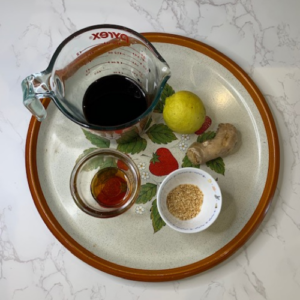
- Once the pot is on the heat, bring the mixture to a full boil. After it boils , remove it from the heat.
- Add the rest of ingredients except Sesame oil and Sesame seed and mix well.

- Add Sesame oil and Sesame seed. Cool it in the fridge. *Note: you can make sauce a day before and keep it in the fridge fridge. It lasts about 1 week.
How to make crepe egg
- For this recipe, using a 26 cm frying pan, you’ll need to cook the eggs in batches:If using 4 eggs, divide them into 3-4 batches.If using 2 eggs, divide them into 1–2 batches.

- Heat the frying pan and add oil
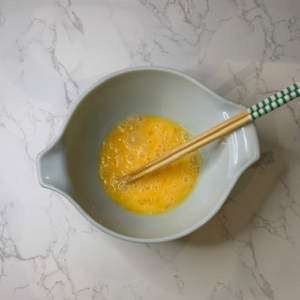
- When the frying pan is hot pour in the egg mixture (here, half the amount for 3 eggs) and immediately tilt the pan in a circular motion to spread the mixture evenly across the entire surface.
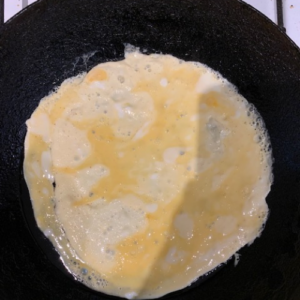
- Once the egg mixture is evenly spread, continue moving the pan in a circular motion. As the egg begins to set and its movement slows, immediately turn off the heat. (*At this point, the egg mixture will have stopped moving but will still appear glossy and slightly undercooked on the surface.
- Cover the frying pan and remove it from the stove. Let the residual heat cook the egg for about 2 minutes.
- After 2 minutes, remove the lid. If the surface is fully cooked and no longer sticky to the touch, it’s done. Since it’s no longer piping hot, you can handle it with your hands to remove it from the pan. Repeat the process with the remaining egg mixture.

- Once all the thin egg sheets are cooked, stack them evenly and slice them into thin strips from one end.
Topping
- Cut cucumber and carrot - thinly sliced
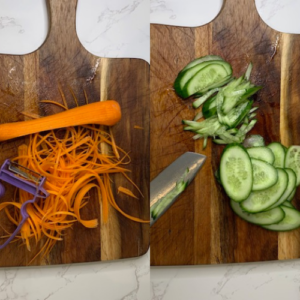
- Cut the tomatoes by removing the stems and slicing them into wedges about 1.5 cm wide. Place the cut ingredients (keeping them together as much as possible) in the refrigerator until the noodles are cooked.
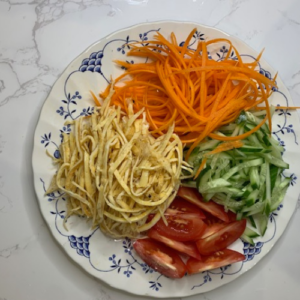
Noodles
- Gently loosen the fresh noodles before adding them to the boiling water, then immediately use chopsticks to separate them. Once the water returns to a boil, reduce the heat slightly and cook for the time specified on the package. When done, drain the noodles in a colander, then return them to the pot. Rinse thoroughly with cold water, drain, and repeat this process 3 to 4 times until the noodles are completely cool.
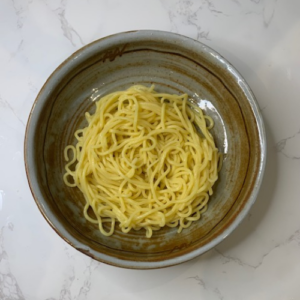
Plating Hiyashi Chuka
- When plating Hiyashi Chuka, start by placing the chilled noodles in a slightly deep flat dish, mounding them neatly in the center.For the toppings, arrange them around the noodles in an aesthetically pleasing way, leaning them against the center to create a colorful and visually appealing presentation.
